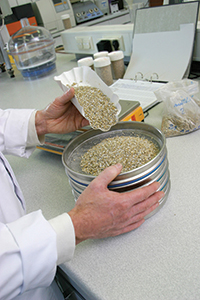
Technical Talk: November 2011
October 31, 2011
By Dr. John Michaelides
Fungi are a diverse group of micro-organisms that play a significant
role in our environment, health, agriculture and the foods we eat.

|
|
| Developing disease resistant wheat varieties takes a long time.
|
Fungi are a diverse group of micro-organisms that play a significant role in our environment, health, agriculture and the foods we eat. They range in size and complexity, from the single cells of yeast to large structures, such as various cultivated and wild mushrooms. Unlike plants, they do not use sunlight as a source of energy, but depend mainly on plant and animal material for food. They decompose plant materials, feeding on these components to produce a biomass that in turn becomes food for microscopic animals. These animals constitute the food that supports larger animals in the food chain. Without fungi, nature would suffocate in its own waste.
Fungi can wreak havoc in agriculture. They have been responsible for major plant disease epidemics that have devastated human communities. The potato blight that ravaged Ireland, causing famine, was brought on by the fungus Phytophthora, a plant pathogen. Today’s crops, with the exception of those making organic claims, are normally protected using fungicides. In some cases, however, fungi use other plants as hosts and infect crops periodically. Wheat rust is one such case. Wheat rust is an infection of the wheat stalk by the fungus Puccinia gramminis, which produces many rust-red coloured pustules on the stem of the plant. Since biblical times, wheat stem rust has been known as the wheat plague. The last major outbreak of a stem rust in North America was between 1950 and 1954. In some years during this period, it destroyed more than 40 per cent of spring wheat crops. Since then extensive breeding of resistant varieties of wheat has almost eliminated outbreaks. In 1999, however, stem rust pustules were discovered on a resistant variety of wheat in a nursery in Uganda. This new virulent strain of stem rust, named Ug99, may overcome the resistance of 90 per cent of known wheat varieties and has been spreading very rapidly. This is a concern because developing and commercializing resistant wheat varieties takes a long time.
In medicine and health, fungi have been both beneficial and detrimental. Some cause serious infections, which can be difficult to treat. On the other hand, some fungi produce antibiotics that are essential in treating bacterial and other infections. Penicillin, the first antibiotic discovered, is produced by the fungus Penicillium.
Many fungi also produce mycotoxins, which have been associated with human illness for millennia. For example, ergotism is the collective term for the severe symptoms that occur after ingesting grain contaminated with the ergot fungus Claviceps purpurea. Ergot grain kernels contain many mycotoxins, including lysergic acid diethylamide, commonly known as LSD. Ergot mycotoxin affected many millers and bakers throughout the Middle Ages. Another serious mycotoxin is aflatoxin. This is produced by Aspergillus flavus, and is commonly associated with peanuts, other nuts and grains.
Mycotoxin poisoning has been a problem throughout human history, however, we have only recently been able to isolate and characterize these chemical compounds. In many cases, they do not cause immediate acute symptoms, but small quantities in our diet may cause chronic health problems, such as cancer. In the early 1980s, contamination of soft wheat in Ontario with vomitoxin caused major problems in the cereal and baking industries. Vomitoxin is produced by the fungus Fusarium, which infects the wheat plant during flowering, entering the wheat through the developing kernel. The fungus grows together with the kernel and produces the toxin within, contaminating the wheat supply and, eventually, food. A number of other mycotoxins have also been identified as problematic in the food chain, particularly in the cereal and baking industries. National and global regulatory bodies have imposed limits on the amounts of mycotoxins permitted in foods.
Fungi can be beneficial in the food and beverage industry. Production of some food products depend on yeast. Bread and other yeast-raised baked good production would be impossible without it. Beer, wine and spirits are also impossible to produce without yeast’s fermenting action. Soy and other grains fermented using different types of fungi have been consumed by many Asian communities for thousands of years. Moreover, a multitude of enzymes are commercially produced by fermentation of a number of fungi. These enzymes are essential in the production of food products, especially baked goods.
New developments indicate that we can use fungi to increase the nutritive value of baked goods. Fungi contain ergosterol, which is the precursor of vitamin D. When fungi are exposed to ultraviolet light, ergosterol converts into vitamin D. There is now commercially available yeast that contains high amounts of vitamin D.
In short, fungi are a diverse and very important group of micro-organisms that can play both a beneficial and a detrimental role in our lives.
For more information, or fee-for-service help with food technical and processing issues and needs, contact Dr. John Michaelides at John Michaelides & Associates at 519-743-8956 or 519-821-2960 ext. 226, or by e-mail at j.jmichaelides@gmail.com.
Print this page
Leave a Reply